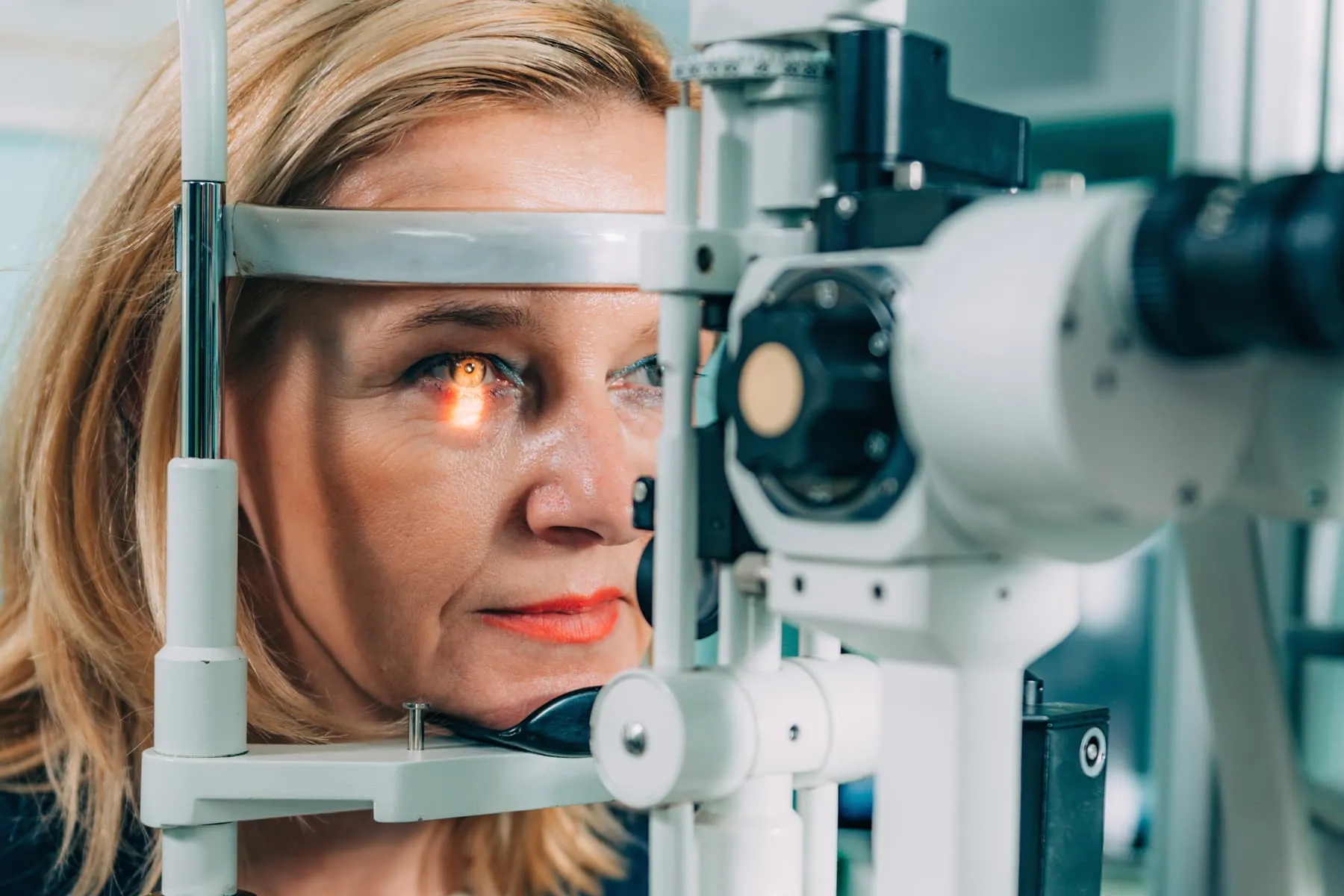May 10, 2024 – When we’re young, we take our macula for granted. At the center of our retina – the deepest layer of the eye that’s chock-full of photoreceptors and that confers color to our world – the macula is like a high-resolution camera. As light hits our eyes, the retina’s macula recasts our world in a bloom of color with astoundingly high visual sharpness.
But as you age, your vision dulls. What once stood out sharply becomes foggy, like condensation on a windowpane. After some time, a coal-black smudge or cloudy circular area begins to affect your central vision.
This effective blind spot widens over time if left untreated. What remains is a “macular hole” in the center of your retina.
This unfortunate series of events marks the advanced stage of age-related macular degeneration, a dangerous retinal disease that affects about 20 million people in the U.S., and nearly 200 million people worldwide.
And it’s not getting better. Estimates are that by 2040, the disease may affect nearly 300 million people worldwide. We are very limited in our ability to treat or prevent it. Read on for what to know.
First, What Causes Age-Related Macular Degeneration?
AMD’s causes are varied, and whether it will affect you is mostly determined by age and genetics, said Marco Alejandro Gonzalez, MD, an ophthalmologist and vitreoretinal specialist in Delray Beach, FL.
Because of the different cocktails that we have in terms of our genetic makeup, some people’s photoreceptor cells in the macula “basically start to shut down,” he said.
AMD’s development involves over 30 genes, and if you have a first-degree relative – parent, sibling, child – who has the disease, you’re three times more likely to get it, too.
Gonzalez explained how the expected rise to 300 million cases by 2040 is due mostly to improved diagnostic tools, along with the fact that the world is getting older and living longer. (Usually, an optometrist can detect signs of AMD during a routine eye exam.)
Eye experts still struggle to stop AMD’s most harmful sign – the cause of those muddy, milky, or even coal-colored circles in your central vision: geographic atrophy.
Geographic atrophy can occur in either of the two forms of age-related AMD: “dry” AMD and “wet” AMD.
Nearly every case of AMD begins as the dry kind, affecting 80% to 90% of AMD patients.
Retinal disease expert Tiarnán Keenan, MD, PhD, offered a vivid image of geographic atrophy for those who have dry AMD.
“As time passes, the circular patches of GA expand like a brushfire, taking more and more vision with it, often to the point of legal blindness,” he said.
A researcher in the Division of Epidemiology and Clinical Applications at the National Eye Institute, Keenan recently led a study that tested the efficacy of the antibiotic minocycline in slowing geographic atrophy expansion in dry AMD. The study operated on the grounds that the body’s immune system could be at play in developing the disease.
When your body’s immune system is overactive, microglial cells (central nervous system immune cells) can get into the sub-retinal space and possibly eat away at the macula and its sensitive photoreceptors.
Though minocycline had been shown to reduce inflammation and microglial activity in the eye in diabetic retinopathy, it didn’t slow the expansion of geographic atrophy or vision loss in patients with dry AMD during Keenan’s study.
When asked if microglial activity could have very little to do with the atrophy expansion, Keenan said it’s something to consider: “Maybe microglia are just there as bystanders clearing up the debris … so inhibiting them is less likely to slow down progression.”
In future drug trials, “maybe it’s possible the minocycline or another approach to target microglia would be helpful, but it would be needed in combination with some other therapy and be ineffective by itself,” he said.
Two Sides of the Same Disease
In dry AMD, Gonzalez compares macular degeneration to the loss of pixels on a screen. “Some of those pixels burn out … and that’s the way you lose vision classically in the dry form.”
Wet AMD is a more progressive form of the disease. It causes abrupt vision loss due to abnormal blood vessel growth.
“If you don’t treat wet AMD quickly, it’s game over,” warned Gonzalez. “Wet macular degeneration is the quicker process of vision loss because these blood vessels wreak havoc.” These new blood vessels bleed, causing fluid to build in the macula, which ultimately leads to scarring.
Gonzalez shed light on why wet AMD develops. “The wet form, for some reason, is the body’s last-ditch effort to try to kind of ‘help’ a dying macula. … When these blood vessels start to grow under the retina, they quickly destroy the architecture of the macula.”
Stopping the Bleeding in Wet AMD
Though wet AMD is rarer, it’s more treatable than dry AMD. Signs and symptoms can be eased with various therapies injected into the eye.
Putting it simply, Gonzalez said these therapies to treat wet AMD “all basically do the same thing. They make these new blood vessels regress temporarily before they cause damage to the macula.”
The injected medication clears away those blood vessels and restores the architecture of the macula. People can recover some vision in this way, but it’s only a temporary tune-up, and shots must be given as often as once a month.
“Degeneration of the cells is still the main problem. You’re not stopping that. But degeneration itself is a lot slower than actual vision loss associated with these blood vessels.”
The Struggle in Developing New Treatments
According to Keenan, “nobody has been able to stop geographic atrophy from happening” in either form of AMD. “So, that’s the main work in the field with trials.”
In December 2023, the FDA approved two new drugs: Syfovre and Izervay, both of which only slow geographic atrophy. Degeneration still happens, regardless.
Keenan explained how these two new drugs are “complement inhibitors … given by injection into the eye once a month or so.”
“Complement” refers to the body’s complement pathway, a trigger that activates a cascade of proteins in enhancing immune response.
Clinical trials showed Syfovre slowing the rate of geographic atrophy by up to 22% over 2 years, and Izervay up to 14% over 1 year.
Though these drugs are a new weapon against this troublesome affliction, they aren’t without their complications.
“Anytime you give an injection in the eye, there’s always the risk of an infection because you’re introducing something from the outside. So that’s the biggest risk,” explained Gonzalez.
An infection is uncommon, but potentially devastating, as you can lose your eye altogether. There’s also the chance of a damaging reaction to the shot.
“You have to pick and choose your patients,” said Gonzalez. “Not everybody is a good candidate for those new shots … and the patient is never going to see better. … It’s a harder sell than the ones for wet AMD.”
A Common Protective Measure
Keenan and Gonzalez both have a fair degree of confidence in reducing the risk of AMD with vitamin therapy.
As a bit of background on how vitamins were found to act as a sort of preventive measure, Gonzalez said, “In the early and late ‘90s, there were series of studies which were called the age-related eye disease studies.” These are now referred to as AREDS 1 and AREDS 2.
Researchers proved that a certain cocktail of vitamins slowed down degeneration. The most is a combo of antioxidants: vitamins C and E and lutein and zeaxanthin, all of which are in the AREDS 2 formula.
People who took these vitamins had a lower chance of losing their vision over the next 2 to 5 years. “[The combo] seems to be complementary and additive … with a combined treatment effect of 55% to 60%, an excellent safety record, and very low cost,” Keenan said.
Gonzalez recommends the AREDS 2 formula of vitamins to every patient of his. “It’s such an easy thing to take, and the downside is minimal.”
Unfortunately, if your genes make you more likely to have the condition, a change in diet or vitamin use could have no effect.
Dire? Possibly. But not all is lost in this fight.
Vigilance with AMD and What to Do Next if You’re Diagnosed
Gonzalez is adamant in educating his patients before time has run out on treating AMD. Recognition is key. “The most common reason a lot of these people get to me ‘too late’ is they don’t realize there’s a problem.”
He explained a typical scenario: “Let’s say you have macular degeneration in both eyes at different stages. One of your eyes starts developing wet macular degeneration … so the better eye takes over and you may not notice there’s a problem.”
Even after a patient is diagnosed with AMD, they usually see a specialist only twice a year. Gonzalez often tells his patients to cover one of their eyes to make sure their vision is intact in both eyes. “You’ll be able to pick up on subtle differences” in each eye, he said.
This type of self-care and vigilance can be the difference between successfully living with and treating the disease for the rest of your life, and trying to get help when it’s simply too late.
For wet AMD, as mentioned before, a round of injections is basically what everyone does. Without quick, invasive treatment, the point of no return approaches rapidly.













![Ep265: [Lean Series] 5 Ways You’re F*cking Up Your Fat Loss Ep265: [Lean Series] 5 Ways You’re F*cking Up Your Fat Loss](https://carrotsncake.com/wp-content/uploads/2025/01/IMG_3025-768x1024-1.jpg)






Discussion about this post